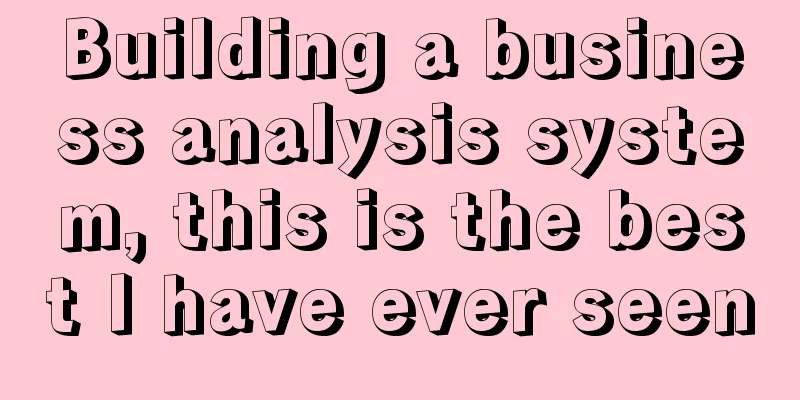Building a business analysis system, this is the best I have ever seen

Many students are writing business analysis reports every day, but they are either dissed for "not being in-depth enough" or they always feel that they are repeating the same template every month... So how do you do business analysis? Today, I will use the most common example to show you how to build a business analysis system. 1. Frequently Asked QuestionsThe biggest pain point of business analysis is that many people do not do business or analysis, which basically means: The formula of GMV=UV*conversion rate*average customer price breaks down the KPI and then starts to perform: "This month's goal was not achieved because the conversion rate was low, and we need to increase it." In addition, many companies have templates for their business analysis reports, which are euphemistically called "historical inheritance." So the "need to increase it" has been passed down from generation to generation. So, what should we do? 2. Ideas to break the impasseThe goal of business analysis is to quantify business actions and assess business results. To achieve this goal, we must first solve a core problem: what is the smallest organization and the most core process in order to make the business run! Only by understanding this can we clearly distinguish the significance of each of the many actions of the enterprise to the business, and then we can sort out the analysis framework. Here we can borrow the concept of MVP (minimum viable product). The essence of business operation is to solve the problem of income and cost. In the early stage of operation, the MVP of the enterprise should prove its ability to generate income, so as to attract people to invest internally and expand the MVP. When the enterprise matures, it can expand based on the MVP model, continuously create cash flow, and then support external investment (as shown in the figure below) The first step in business analysis is naturally to disassemble the company's MVP framework. Step 3: Disassemble MVPMVP needs to prove that it can generate revenue. To generate revenue, at least three key links are required: customer acquisition, service, and transaction. In the work of these three links, various costs will be incurred. Therefore, the core of disassembling MVP is to disassemble the customer acquisition, service, and transaction processes. Some business models are very complex and difficult to disassemble. Here is a simple example to show you how to do it. Consider the simplest business model: opening a braised chicken and rice shop.
Arrange it into the following picture, and it's done! (As shown below) 4. Step 2: Calculate MVPMVP needs to prove that its revenue can cover the cost and have a survival significance. Therefore, the second step is to calculate the revenue and cost of the MVP process. The income formula is relatively simple and can be written in one formula (as shown below) Costs need to be calculated separately, distinguishing between fixed costs and variable costs (as shown below) After this step, the most important income and cost indicators in business analysis are clearly listed, and the business results can be calculated. But this step alone is not enough, and we also need to see: what are the key factors that affect the business. If the key factors are not monitored, the business data will become a paper article, and it is impossible to truly interpret: why the business is good or why it is bad. 5. Step 3: Consider key business factorsLet's take the simplest braised chicken rice restaurant as an example. For a small restaurant with a single dish, the most important thing is the location. If the location is not good, such as too few people and too many similar restaurants around, then the restaurant will fail. Therefore, the most important thing to consider is the quantification of the key factors: location. There are two common approaches: First: label and add analysis dimensionsfor example: Urban area: CBD/city center/suburbs/external suburbs Street location: community gate/hospital gate/school gate/pedestrian street/food street Neighboring peers: There are similar stores/There are no similar stores but there are fast food restaurants/There are large restaurants without fast food restaurants/There are no restaurants. Labeling can quantify some important factors that are difficult to describe quantitatively. Second: Look at the process and add analytical indicatorsFor example, we can break down the indicator into: income = traffic in front of the store * store entry rate * transaction rate * transaction amount. After breaking it down in this way, the traffic in front of the store can be observed before opening the store. Even with the most primitive observation method (standing in front of the door with a counter and clicking once for each person), it can be counted. The same is true for the store entry rate, at least it can be counted. In this way, we can know whether there are people at a certain position. If there is no one at a certain position, or there are people but they are not eating, then they can be eliminated directly. With labels and indicators, you can do cross-analysis to see under which circumstances the store survives better. If it is a pre-study, you can find out the key to the success of the store. If it is a post-analysis, you can summarize the characteristics of a successful store (as shown below). Of course, there may be many factors that affect the opening of a store, including completely uncontrollable factors such as the epidemic. Business analysis can only restore these factors as much as possible, and cannot replace the outstanding performance of excellent individuals, let alone luck. Remember this. With MVP accounting + key factors, the operating benefits can be roughly analyzed. However, enterprises will not be satisfied with the simplest model and will definitely expand it, which is the next step. Step 4: Expand MVPI guess some students wanted to say at the beginning: Don’t be so naive, we can do a lot of tricks. Yes, even if you only open a shop selling braised chicken and rice, there are still many ways to do it. for example: 1. Add dishes: braised short ribs and braised pork belly 2. Add drinks: beer, beverages, and mineral water 3. Increase customer acquisition: Meituan and Ele.me are on board 4. Increase consumption: Order a set meal and get a free braised egg, and a 5 yuan discount for a meal for two. Yes, there are many ways to increase transactions. From the perspective of business analysis, these are all ways to expand MVP. Each method has the potential to increase revenue, but also brings corresponding costs. Therefore, it is necessary to distinguish: how does each method expand revenue? How much will the cost increase each week? This is the key to expanding MVP. Different methods have different effects:
Of course, some have comprehensive effects. The most common one is price reduction. When prices are lower, all indicators except the average order value are affected. When expanding MVP, you should pay attention to carefully sorting out each expanded business process and sorting out the relationship between each action and revenue and cost in order to observe the effect (as shown in the figure below). Of course, not all businesses are as simple as braised chicken. Some may involve complex departmental coordination. Therefore, the following classification can be used to distinguish business characteristics (as shown below). This is just like building blocks, gradually enriching the entire system from the simplest formula and monitoring every link that may affect operating results. 7. Difficulties in realityOverall, the process of building a business analysis system is actually a process of continuous sorting and gradual refinement. So why is business analysis always so difficult in reality? Note! Although it is called "braised chicken rice", it is: 1. Open your own shop and buy and sell braised chicken 2. Open a chain store to sell braised chicken 3. Open a franchise store of "Lao Chentou" braised chicken These are three different business scenarios, so different that each needs to be sorted out separately. They cannot be mixed together. Some companies' businesses are like this, mixed in various forms, so it is difficult to sort them out clearly. But there are still many companies that have problems purely due to human factors. For example, the business department takes credit for themselves and acts unreasonably, while the data department works behind closed doors and does not understand the business. These human factors are difficult to eradicate, so they cannot go deeper. Business analysis is to abstract the entire business situation into something that can be measured by data, which itself has very high requirements for data quality and business understanding. Only by doing both can we get a good grasp. |
>>: 2024, they will explode overseas markets
Recommend
Video accounts enter local life again
In the field of local life, the video account is a...
20 experiences in making mini programs!
Are there any friends who want to make a mini prog...
How to start cross-border e-commerce? How to start cross-border e-commerce?
Cross-border e-commerce provides new opportunities...
Why is the PayPal fee so expensive? Is there a cap?
Domestic sellers doing cross-border e-commerce bus...
What are the risks of cross-border e-commerce? Can you make money?
With the development of globalization, cross-borde...
Luckin Coffee’s WeChat store received over 10,000 “gifts” in one day
In the wave of digital marketing, the "Send G...
The new top-selling sugar-free tea has brought the price war down to 2 yuan
In the summer of 2024, sugar-free tea became the n...
What are the sources of Amazon traffic? How to get it?
Many friends on Amazon now do promotion, because i...
Moutai Luckin's knife skills
Today, Luckin Coffee and Moutai jointly launched t...
Uncovering the secrets of short play script trading: 90% of them are rejected in the first review, and the popular screenwriters earn 100,000 yuan a month
While short plays are popular, the script transact...
The Sannong account with 6 million followers has been disbanded
The Sannong self-media track is a media platform t...
How to revive a small business?
With the advent of the opening-up policy, I believ...
It’s scary. Why do all the copywriting nowadays seem to be from the same mother?
This article explores the common problems in moder...
Will the points deducted by Shopee be reset to zero every month? How many points will Shopee deduct before freezing the account?
Today, I will introduce you to the content of open...
Resignation from large companies has become the secret of traffic. Have these young people made money?
Why do people who have resigned from big Internet ...









